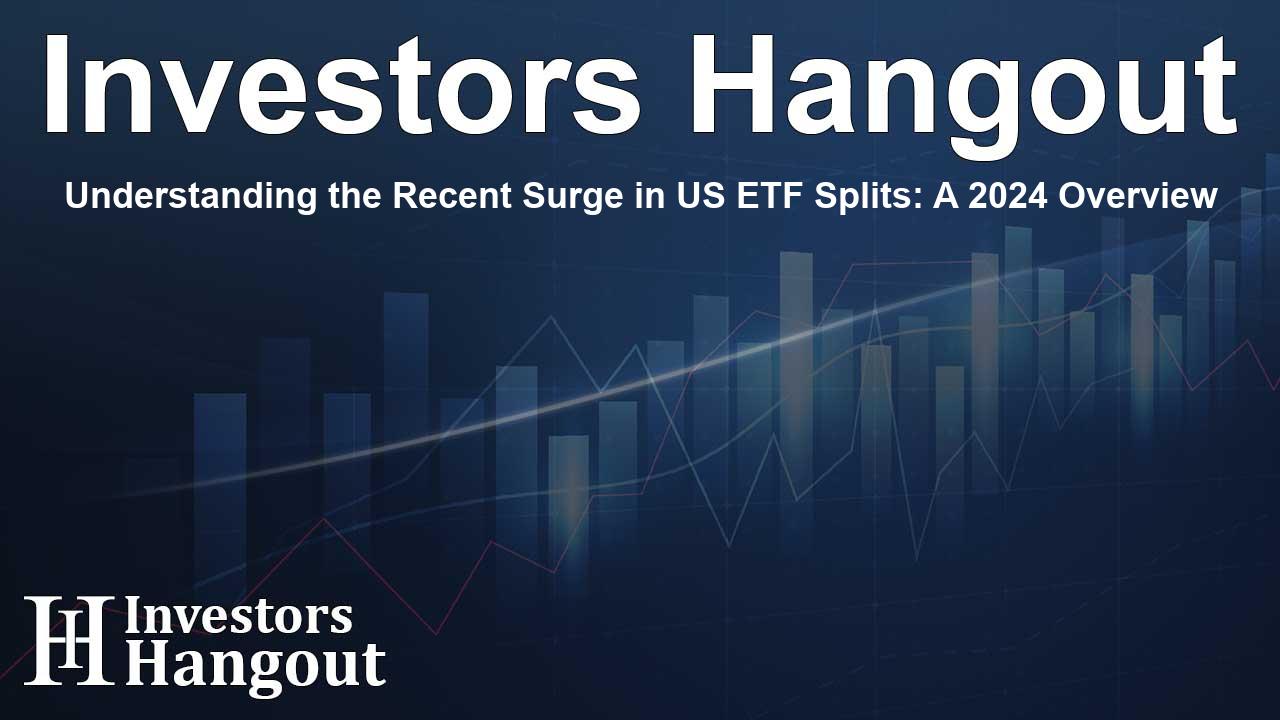Understanding the Recent Surge in US ETF Splits: A 2024 Overview

Understanding the Landscape of Recent ETF Splits
Recently, there has been a significant increase in the number of ETF splits observed in the market. The fourth quarter of 2024 displayed a remarkable spike, marking the largest volume of splits in the past four years. This trend doesn't indicate panic for investors who follow an asset-allocation approach; instead, it showcases critical trends currently shaping the investment world.
In total, there were 55 ETF splits, incorporating a blend of traditional and reverse types. Notably, 20 of these splits originated from Schwab’s extensive selection of funds. Issuers often use the year's end for internal adjustments, such as executing splits and managing dividend distributions. While index ETF investors generally encounter a lower distribution risk, splits remain prevalent. It’s essential to understand that a split—whether for a stock, mutual fund, or ETF—is primarily an accounting adjustment. Think of it as a straightforward exchange of a dime for two nickels.
Unpacking the Trend: Increased Split Announcements
Historical data suggests that equity shares of companies announcing traditional splits, like a '2-for-1' stock split, can potentially generate excess returns. This was particularly common during the 1980s and '90s. However, recent patterns have shown a decline in stock-split outperformance. Research from Goldman Sachs indicates that since 2019, those companies announcing splits have displayed only modestly improved returns compared to the market overall, according to insights shared in 2024.
On the other hand, reverse splits—such as a '1-for-10'—carry the possibility of downside risk, which tends to occur when a stock has underperformed. Various studies reveal that reverse-split stocks generally experience average negative abnormal returns.
Insights into Current ETF Trends
The last few months highlighted an intense wave of split announcements concentrated on inverse and leveraged ETFs. Among the announced splits, in addition to the 20 from Schwab’s broad index ETFs, 24 of the other 35 splits were inverse ETFs, while 28 were leveraged products. Intriguingly, 20 were both inverse and leveraged funds, reflecting a unique aspect of current market dynamics.
It is essential to note that leveraged ETFs inherently carry high risks due to their daily reset feature, which can lead to what’s known as the 'negative compounding effect.' For example, envision an S&P 500 index fund priced at $100. If the index increases by 10%, a 3x leveraged ETF could rise to $130, while the index reaches $110. However, if the next day the market dips by 10%, the S&P 500 retreats to $99, but the leveraged fund falls dramatically to $91, resulting in notable underperformance compared to the index.
This leveraged ETF price decay may persist over time, particularly during periods of volatility, subsequently degrading the ETF's net asset value. For some underperforming sectors, notably in energy commodities like natural gas, a leveraged ETF might dwindle to levels undesirable for the issuer, prompting a reverse split announcement.
The Scarcity of Traditional Splits
Remarkably, only three traditional ETF splits from non-Schwab entities were recorded in Q4 2024. Following an extensive bull market in diverse sectors, issuers might be inclined to adjust market prices downward, but the scarcity of traditional splits raises questions. The evolution of trading environments allowing fractional share trading has diminished the importance of traditional splits in the marketplace. Nevertheless, ProShares executed traditional splits for three of its funds in sectors like leveraged health care and semiconductors.
In stark contrast, the vast majority of splits witnessed last quarter were reverse splits. Out of 35 non-Schwab splits, an astonishing 32 were of the reverse nature, mainly seen in leveraged ETFs. Many such splits stemmed from the ProShares UltraShort series of bearish leveraged funds, indicating that the consequences of the negative compounding effect necessitated these actions.
The Rise of Single-Stock ETFs
Intriguingly, two companies emerged in the ETF split discussions during Q4 2024. The rise of single-stock ETFs gained traction, partly fueled by fluctuations in AI and crypto-related equities which caught the attention of investors.
ETFs linked to Super Micro Computer (NASDAQ: SMCI) and MicroStrategy (NASDAQ: MSTR) sparked interest in new investment avenues. Specifically, the Defiance Daily Target 2X Long SMCI ETF (SMCX) executed a reverse split alongside two leveraged inverse funds tied to MSTR. As market volatility continues, further splits in single-stock ETFs could become more frequent.
Summary: The Future of ETF Splits
The fourth quarter of 2024 witnessed a noteworthy increase in US ETF splits, as key players like Schwab adjusted their index funds through traditional splits. Nevertheless, many leveraged and inverse funds experienced declines in share prices that prompted these reverse splits—highlighting a possible trend of bearish market conditions since the S&P 500's low in late 2022. Moreover, the emergence of single-stock ETFs emphasizes the expansion and diversification of investment options available to modern traders.
Frequently Asked Questions
What are ETF splits?
ETF splits are adjustments in the number of shares outstanding for an exchange-traded fund, typically affecting the fund's share price without changing its overall market value.
Why are reverse splits common among leveraged ETFs?
Reverse splits are often used to increase the share price of leveraged ETFs that have declined due to the negative compounding effect, making them more appealing to investors.
How do traditional ETF splits benefit investors?
Traditional ETF splits can make shares more affordable for retail investors, potentially enhancing liquidity and interest in the fund.
What trends influenced the rise in single-stock ETFs?
The increased volatility in high-profile sectors such as AI and cryptocurrency has driven interest in single-stock ETFs, offering tailored investment opportunities.
What does the decrease in traditional splits indicate?
The decline in traditional splits may suggest a shift in investment strategies, as fractional trading gains popularity, reducing the traditional need for price adjustments through splits.
About The Author
Contact Dylan Bailey privately here. Or send an email with ATTN: Dylan Bailey as the subject to contact@investorshangout.com.
About Investors Hangout
Investors Hangout is a leading online stock forum for financial discussion and learning, offering a wide range of free tools and resources. It draws in traders of all levels, who exchange market knowledge, investigate trading tactics, and keep an eye on industry developments in real time. Featuring financial articles, stock message boards, quotes, charts, company profiles, and live news updates. Through cooperative learning and a wealth of informational resources, it helps users from novices creating their first portfolios to experts honing their techniques. Join Investors Hangout today: https://investorshangout.com/
The content of this article is based on factual, publicly available information and does not represent legal, financial, or investment advice. Investors Hangout does not offer financial advice, and the author is not a licensed financial advisor. Consult a qualified advisor before making any financial or investment decisions based on this article. This article should not be considered advice to purchase, sell, or hold any securities or other investments. If any of the material provided here is inaccurate, please contact us for corrections.
